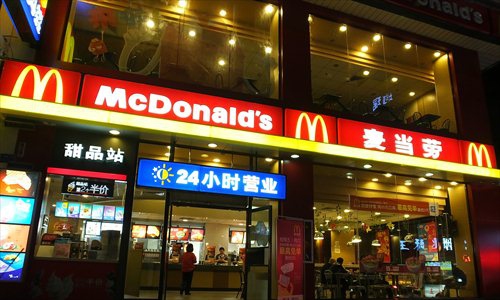SOURCE / INDUSTRIES
Why does McDonald’s close in UK while it operated well in China during coronavirus outbreak?

File photo
Fast-food giant McDonald's will shut down all of its restaurants in the UK and Ireland as the coronavirus outbreak there escalates. However, its Chinese counterparts kept operating when the coronavirus hit China hard. Experts said that China's advanced digital economy and logistics system explained the difference.The fast-food company said on Twitter that it has taken a "difficult decision" to close all its outlets in the UK and Ireland as of 7 pm on Monday at the latest, including its takeaway and drive-through services.
Prior to that, McDonald's had reduced overnight opening hours and closed seating areas in restaurants in the region in an effort to enforce social distancing amid the coronavirus outbreak in the UK.
"Over the last 24 hours, it has become clear that maintaining safe social distancing while operating busy takeaway and Drive Thru restaurants is increasingly difficult," Paul Pomroy, chief executive of McDonald's UK and Ireland, was quoted as saying.
This problem facing McDonald's in the UK, however, was handled well by Chinese fast-food chains during the coronavirus outbreak in China, where dine-in service and online food delivery service remained running in most cities.
The reason why fast-food chains like McDonald's and KFC were able to keep operating in China owed much to China's advanced digital economy, mobile payments and online-to-offline (O2O) catering services, Lu Zhenwang, an independent e-commerce expert, told the Global Times on Monday.
During the coronavirus pandemic, China's McDonald's and KFC used non-touch ordering services in restaurants and encouraged customers to order on mobile phone apps.
On China's McDonald's mini WeChat App, for example, customers can order and pay in advance on their mobile phones and choose a time to pick up their meals, which greatly limits people-to-people contact at the counter during the ordering process.
Aside from walk-in take-away service, China is also leading in the online food delivery platforms.
"Chinese fast-food companies launched takeaway services on O2O catering and food delivery platforms such as Ele.me and Meituan at an early stage. The number of orders placed online is very high, which offsets their loss of offline business," Lu said.
During the coronavirus pandemic, new business trends also emerged that greatly accelerated the development of the digital economy era.
At end-January both McDonald's and KFC in China came up with "contactless delivery" service almost at the same time.
Under this mode, riders don't have to have direct contact with customers but place meals in a designated location to minimize the risk of human-to-human transmission. The take-out paper bag will also be sealed.
"China's O2O food delivery business and mobile payments in China are more developed compared with the US and Europe where dine-in and credit cards remains the mainstream," Lu said.
Mobile payment business maintained rapid growth throughout 2019, according to a report released by the People's Bank of China on March 17.
In 2019, Chinese banks handled 101.431 billion mobile payments, with a value of 347.11 trillion yuan ($48 trillion), an increase of 67.57 percent and 25.13 percent year-on-year, respectively. The growth rate was the fastest among all businesses of the banks.
This means each of 1.4 billion Chinese people across the country had an average of about 72 mobile payments in the past year.
